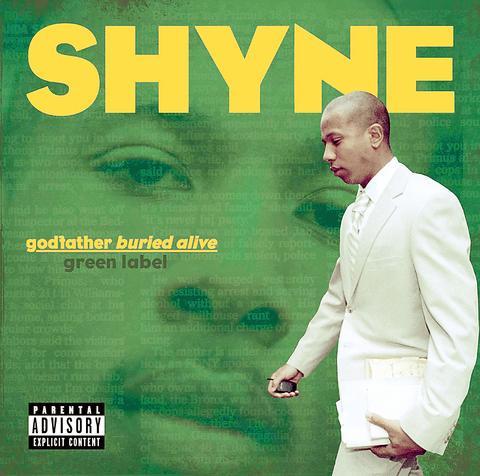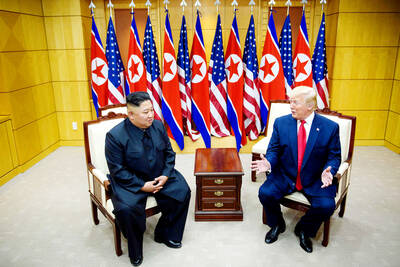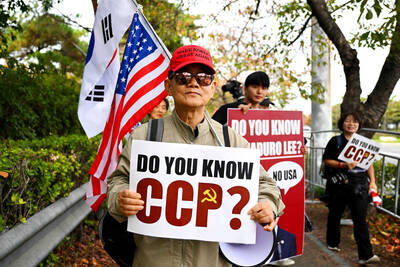In the calculating eyes of music industry executives, the rap artist Jamaal Barrow possesses the sort of street credibility that instantly draws fans and sells records -- a prison sentence. Unfortunately for them, he's serving it right now.
Barrow, professionally known as Shyne and a former protege of the rap music impresario Sean Combs, was heavily courted this winter despite being just three years into a 10-year sentence for a shooting while he was with Combs at a Manhattan nightclub. But now, after signing Shyne to a multimillion-dollar-record contract to put out some of his unreleased recordings, executives at Vivendi Universal's Def Jam Recordings are finding that some of the very traits that stirred up such interest -- his hardcore image and tangles with the law -- may prove to be major drawbacks as they market his new album, Godfather Buried Alive, due out in the US on Tuesday.

PHOTO: NY TIMES
With the performer behind bars in upstate New York, a concert tour is out of the question. So is the customary swing through radio station studios in the biggest markets. The New York State Department of Correctional Services has started to enforce rules limiting the number of reporters who can visit. And whatever modest publicity efforts Shyne can undertake will not take place on Friday nights or Saturdays -- he recently began observing the Jewish Sabbath, a nod, he says, to his great-grandmother, an Ethiopian Jew.
"No one would want to be here," Shyne said in a telephone interview last week from the Clinton Correctional Facility. "I wouldn't wish this on my worst enemy. I have to make the best of it. I am here and I have adjusted. I've found a way to stay on top of everything."
Overcoming the hurdles prison places on marketing is not impossible, as the rapper Tupac Shakur proved.
"The truth about it is," said Antonio Reid, the chairman of the Island Def Jam Music Group, "there are times when our marketing plans don't really include the artist anyway -- maybe it costs too much to move them around, maybe the artist doesn't live in the US."
"I know I can't do anything with him," Reid said of Shyne. "We approach it like he's just in Japan."
But in some ways, the prison, in Dannemora, New York, is farther away than Japan, and that has cast a cloud over the future for both Shyne and Def Jam executives.
Shyne, 25, who grew up in Belize and Brooklyn, New York, was signed by Combs' Bad Boy Records label in 1998, his tales of bloodshed and inner-city alienation eliciting comparisons to another of Combs' rap stars, Christopher G. Wallace, who was known as Notorious B.I.G. and was shot to death in 1997.
But it was another connection with Combs that led Shyne to his current residence. On Dec. 27, 1999, Shyne was among the entourage of Combs and Combs' girlfriend at the time, Jennifer Lopez, at Club New York in Manhattan. After another patron insulted Combs, a melee erupted and the violence escalated into gunfire, injuring three bystanders.
Witnesses said Shyne had fired a handgun wildly into the crowd. He was convicted in 2001 of assault, criminal possession of a weapon and reckless endangerment, and sentenced to 10 years in prison with no eligibility for parole until 2009. Combs, also known to fans then as Puff Daddy and now as P. Diddy, was charged with illegal possession of a gun and bribery and acquitted at the same trial. (Shyne said last week that Combs betrayed him by not speaking up in his defense; Combs declined to comment.)
But before the trial, Shyne had recorded his first album, Shyne, which has sold more than 900,000 copies since its release in 2000, according to Nielsen SoundScan. So when word spread last fall of other recordings made before he began serving his sentence, top music industry executives began making the trek to the Clinton Correctional Facility to woo Shyne.
Def Jam beat out competitors, signing Shyne to a two-album deal that could pay him an estimated US$6.5 million in advances.
Given the size of the deal, rival record label executives estimate Def Jam will have to sell about 900,000 copies for Godfather Buried Alive to break even. It contains mostly old, unreleased recordings and at least one made by telephone in calls from prison.

US President Donald Trump may have hoped for an impromptu talk with his old friend Kim Jong-un during a recent trip to Asia, but analysts say the increasingly emboldened North Korean despot had few good reasons to join the photo-op. Trump sent repeated overtures to Kim during his barnstorming tour of Asia, saying he was “100 percent” open to a meeting and even bucking decades of US policy by conceding that North Korea was “sort of a nuclear power.” But Pyongyang kept mum on the invitation, instead firing off missiles and sending its foreign minister to Russia and Belarus, with whom it

When Taiwan was battered by storms this summer, the only crumb of comfort I could take was knowing that some advice I’d drafted several weeks earlier had been correct. Regarding the Southern Cross-Island Highway (南橫公路), a spectacular high-elevation route connecting Taiwan’s southwest with the country’s southeast, I’d written: “The precarious existence of this road cannot be overstated; those hoping to drive or ride all the way across should have a backup plan.” As this article was going to press, the middle section of the highway, between Meishankou (梅山口) in Kaohsiung and Siangyang (向陽) in Taitung County, was still closed to outsiders

Many people noticed the flood of pro-China propaganda across a number of venues in recent weeks that looks like a coordinated assault on US Taiwan policy. It does look like an effort intended to influence the US before the meeting between US President Donald Trump and Chinese dictator Xi Jinping (習近平) over the weekend. Jennifer Kavanagh’s piece in the New York Times in September appears to be the opening strike of the current campaign. She followed up last week in the Lowy Interpreter, blaming the US for causing the PRC to escalate in the Philippines and Taiwan, saying that as

The Chinese Communist Party (CCP) has a dystopian, radical and dangerous conception of itself. Few are aware of this very fundamental difference between how they view power and how the rest of the world does. Even those of us who have lived in China sometimes fall back into the trap of viewing it through the lens of the power relationships common throughout the rest of the world, instead of understanding the CCP as it conceives of itself. Broadly speaking, the concepts of the people, race, culture, civilization, nation, government and religion are separate, though often overlapping and intertwined. A government